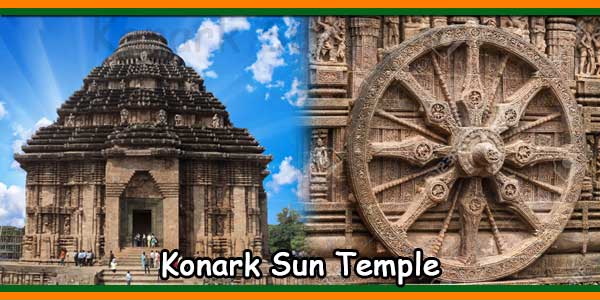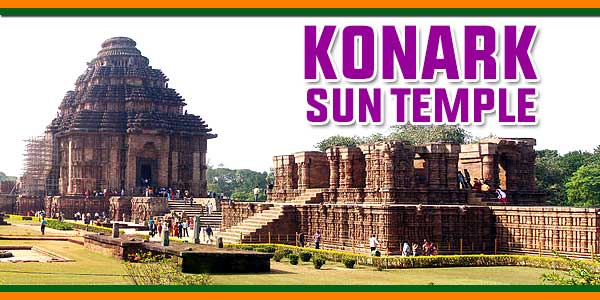The word “Konark” is a combination of two words “Kona” and “Arka”. ‘Kona’ means ‘Corner’ and ‘Arka’ means ‘Sun’, so when combined it becomes ‘Sun of the Corner’. The Konark Sun Temple is located in the northeast corner of Puri and is dedicated to the Sun God. Konark is also known as Arka khetra.
The Konark Sun Temple was built in the middle of the 13th century, is a massive conception of artistic signification and engineering dexterity. This temple was built by King Narasimhadeva I, the great ruler of the Ganges dynasty, with the help of 1,200 craftsmen over a period of 12 years (1243-1255 AD). Konark Temple was designed as a superbly decorated chariot mounted on 24 wheels, each about 10 feet in diameter, and drawn by 7 powerful horses. It is really difficult to understand how this immense temple, each centimeter of space so wonderfully carved, could have been completed in such a short time. Either way, the Konark Temple, even in its current state of ruin, remains a wonder for everyone. The great poet Rabindranath Tagore wrote about Konark: Here, the language of stone exceeds the language of man.
Around the base of the temple are pictures of animals, foliage, warriors on horseback and other interesting structures. Beautiful erotic figures are carved on the walls and ceiling of the temple. There are three images of the Sun God, positioned to capture the rays of the sun at dawn, noon and sunset. Konark Sun temple is a masterpiece of medieval Odisha architecture.
The large structure of the Konark temple seen today is actually the entrance to the main temple. The main temple which consecrated the presiding deity has fallen and only the remains are visible.
Devotees gather for Chandrabhaga mela around the month of February.

Konark Sun Temple Timings:
From Morning 6:00 AM to 8:00 PM on All Days.
Konark Sun Temple Dress Code:
There is no specific Dress Code to enter Konark Sun Temple, Any decent outfits are allowed.
Konark Sun Temple History:
Since the time of Muhammad Ghori, Odisha was raided several times by the Muslims, but the Hindu kings of Odisha could resist them definitely for a longer period. The Hindus were aware that it would be rather impossible for them to tackle with such a warrior nation and to drive them permanently out of their country. Still, they went on taking aggressive parts in such a way, that they could delay the Muslim occupation in Odisha, for about two centuries more. By the middle of the 13th century, when the Muslims had conquered the whole of northern India and most parts of neighboring Bengal, there was hardly any power that could check their advance and it was thought that the Hindu Kingdom of Odisha would soon be overrun by them. At that time Narasimhadeva I started taking the offensive against them.
After the death of Sultan Iltutmish, in 1236 AD, the throne of Delhi remained for a week for some time, when Nasiruddin Mahammad succeeded him and appointed Tughan Khan, Governor of Bengal. A great fight took place between the Muslim army, under the command of Tughan Khan and Narasimhadeva I, in Katasin, in the year 1243 AD, where they were were completely defeated and fled. The great loss of human life in this war was so serious. Narasimhadeva’s victory in this war must have greatly enhanced his prestige in the eyes of contemporary Hindu kings and as such, he wanted to build a temple to represent both a shrine and a Kirti-Stambha / victory memorial to commemorate his victory according to his royal status and prestige.

Konark Building Purpose:
The beauty of the sunrise and the roaring voice of the sea captivated Narasimhadeva from his youth. The now-dead Chandrabhaga River once flowed a mile north of the temple site and joined the sea. On its banks were flourishing cities and important shopping centers. Trade was also done with foreign countries, by sea, because there was no better communication than the river at that time.
Narasimhadeva had preferred the place for his proposed temple because it allowed him not only to bring his building materials from different places along the said river but also to consider its sanctity. In this regard, there is an interesting legend which, once Samba, the son of Sri Krishna, incurred the displeasure of Narada. Who took revenge by making Samba suffer from leprosy. Finally, when Samba was found innocent, he was advised to practice penance in the Maitreyi forest for 12 years, to please Surya (God of the Sun) to cure him of his illness. He acted accordingly and after the prescribed period, the Sun appeared before him and asked him to recite the twenty-one different names of the deity. The next morning, while Samba was swimming in Chandrabhaga, his hands came into contact with something in the water. He immediately picked it up and saw a picture of Surya (God of the Sun) standing on a lotus pedestal, holding two lotuses in his two hands. He brought the image to his Ashrama (hermitage) and installed it in a temple, built by him. However, Samba was completely healed after a while worshiping the deity.
In addition to the sanctity and the favorable environment, the presence of majestic seas eternally roaring and rolling at a surprising distance was perhaps an additional attraction for them.
Konark Sun Temple Architecture:
The area of the whole compound is about one thousand, eighty-one acres, out of which the sun temple alone occupies an area of about two hundred acres of land. The temple was built in the form of a huge chariot of the Sun god fitted with 24 wheels i.e. 12 wheels on both sides and 7 horses in front of the temple. The wheels probably represent the 12 months of a year and the horses, seven days of the week. This temple consists of a Vimana ( main temple ) intended for housing the deity, Jagamohana ( hall in front of Vimana ) from where the worshippers could have a glimpse of the deity and a Nritya-mandapa ( dancing hall ), but a separate Bhoga-mandapa (offering hall ), was not built at this place. Dancing and offering both were probably done in the same building. In Konark, while the Viman (main temple) and Mukhasala (porch) are built on one platform, the Naata Mandir (Hall of Dance) is in a separate platform although on a similar line. Except for the Pitha (platform) the shape of the temple is similar to those at Puri and Bhubaneswar. The eastern gateway which is the main entrance to the temple compound is decorated with Gajasimha (lion upon an elephant) images, with outward faces, installed on two high stone benches are also provided at the inner sides, possibly meant for the guards to sit. A regular stone pavement has been discovered within the passage, which is about 3 feet (0.91 metres) lower than that of the stone around the main temple. It is, therefore, not likely that the original level of the temple compound was the same, like that of the said pavement.
Attractions Near Konark Sun Temple:
Ramachandi
Chandrabhaga
Kakatpur
Kuruma
Chaurasi
Balighai
Beleswar
How to Reach Konark Sun Temple:
By Air:
Biju Patnaik International Airport in Bhubaneswar is the nearest airport which is 62 km from Konark Temple and 36.9 km from Puri Jagannath Temple.
By Train:
Bhubaneswar Railway station is the nearest railway station, direct trains are available to Bhubaneswar station from all parts of major cities.
By Road:
This temple is well connected with all parts of the major cities in all states of India.
Konark Sun Temple Address:
Konark,
Odisha – 752111.
Phone: (06758) 236820
